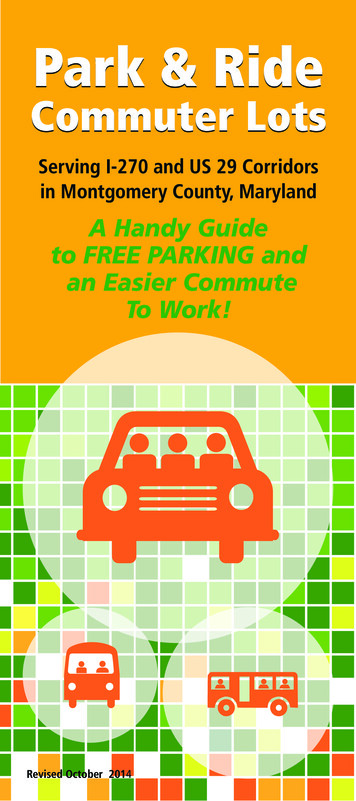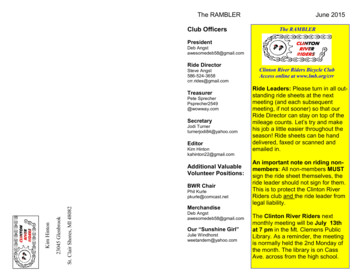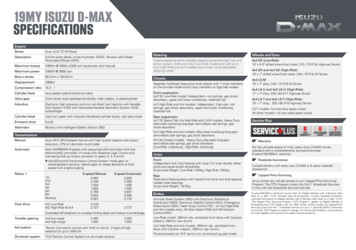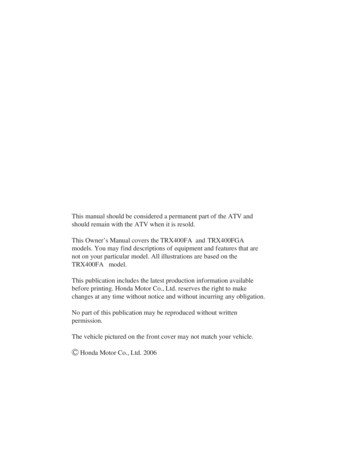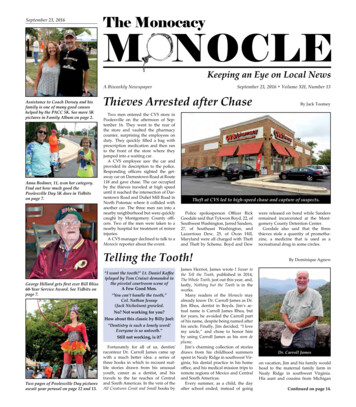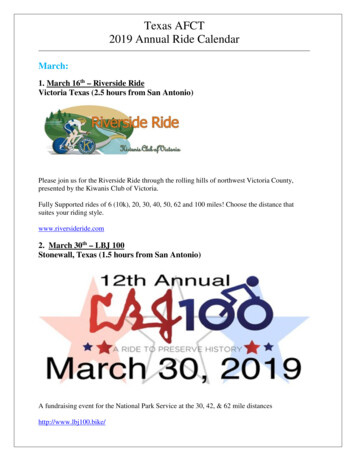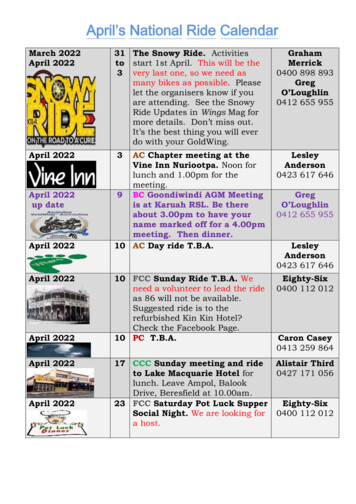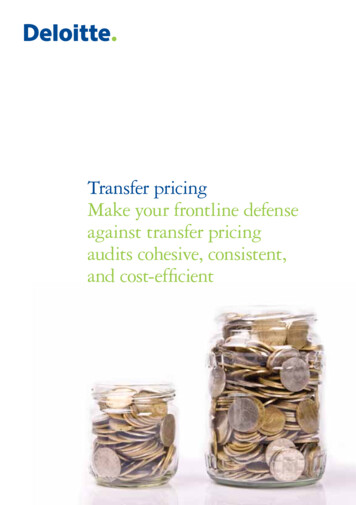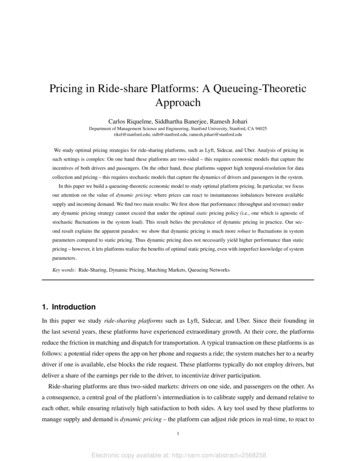
Transcription
Pricing in Ride-share Platforms: A Queueing-TheoreticApproachCarlos Riquelme, Siddhartha Banerjee, Ramesh JohariDepartment of Management Science and Engineering, Stanford University, Stanford, CA 94025rikel@stanford.edu, sidb@stanford.edu, ramesh.johari@stanford.eduWe study optimal pricing strategies for ride-sharing platforms, such as Lyft, Sidecar, and Uber. Analysis of pricing insuch settings is complex: On one hand these platforms are two-sided – this requires economic models that capture theincentives of both drivers and passengers. On the other hand, these platforms support high temporal-resolution for datacollection and pricing – this requires stochastic models that capture the dynamics of drivers and passengers in the system.In this paper we build a queueing-theoretic economic model to study optimal platform pricing. In particular, we focusour attention on the value of dynamic pricing: where prices can react to instantaneous imbalances between availablesupply and incoming demand. We find two main results: We first show that performance (throughput and revenue) underany dynamic pricing strategy cannot exceed that under the optimal static pricing policy (i.e., one which is agnostic ofstochastic fluctuations in the system load). This result belies the prevalence of dynamic pricing in practice. Our second result explains the apparent paradox: we show that dynamic pricing is much more robust to fluctuations in systemparameters compared to static pricing. Thus dynamic pricing does not necessarily yield higher performance than staticpricing – however, it lets platforms realize the benefits of optimal static pricing, even with imperfect knowledge of systemparameters.Key words: Ride-Sharing, Dynamic Pricing, Matching Markets, Queueing Networks1. IntroductionIn this paper we study ride-sharing platforms such as Lyft, Sidecar, and Uber. Since their founding inthe last several years, these platforms have experienced extraordinary growth. At their core, the platformsreduce the friction in matching and dispatch for transportation. A typical transaction on these platforms is asfollows: a potential rider opens the app on her phone and requests a ride; the system matches her to a nearbydriver if one is available, else blocks the ride request. These platforms typically do not employ drivers, butdeliver a share of the earnings per ride to the driver, to incentivize driver participation.Ride-sharing platforms are thus two-sided markets: drivers on one side, and passengers on the other. Asa consequence, a central goal of the platform’s intermediation is to calibrate supply and demand relative toeach other, while ensuring relatively high satisfaction to both sides. A key tool used by these platforms tomanage supply and demand is dynamic pricing – the platform can adjust ride prices in real-time, to react to1Electronic copy available at: http://ssrn.com/abstract 2568258
2Riquelme, Banerjee, Johari: Pricing in Ride-share Platformschanges in ride requests and available drivers. The central focus of this paper is in understanding how thesetwo features of ride-sharing platforms – their two-sided nature, and the ability to price based on real-timestate – influence the volume of trade and the revenue of the platform.To capture the fast-timescale dynamics of ride-sharing platforms, we employ a queueing theoreticapproach. Our primary modeling contribution lies in combining this queueing model for the underlyingstochastic dynamics, with an equilibrium analysis that captures incentives of both drivers and passengers,as well as throughput/revenue maximization by the platform. The general model we consider is one wherea geographic area is divided into regions. Each ride involves a driver picking up a passenger in one region,and dropping her off in another. For simplicity, we analyze this model first for a single region; subsequently,using tools from classical queueing theory, we generalize some of our results to networks of regions.Key to our model is an intrinsic timescale separation in the behavior of drivers and passengers. In ridesharing platforms driven by mobile apps, passengers are typically sensitive to the immediate price of theride that they request. If this price is too high, price-sensitive customers will abandon. On the other hand,drivers are typically sensitive to the average wages they earn over a longer period of time, usually severaldays or a week. Thus, drivers often select certain periods of time when they are “active” during the week,and adjust their activity levels based on their assessment of earnings during the last week. This timescaleseparation has two implications on agent dynamics in our model:1. We model passengers as living for one ride, while drivers (probabilistically) re-join the platform aftereach ride. Thus, drivers have “long” lifetimes in our model, while passengers have “short” lifetimes.2. We model passengers’ entry decisions as being based on the immediate price they are shown, whichis a function of the current state of the region where the passenger opens her app; if the price is belowa passenger-specific reservation value, then the passenger requests a ride. By contrast, we assume thatdrivers’ entry decisions are made by comparing their expected lifetime earnings with their expectedlifetime; if this wage rate exceeds a driver-specific reservation wage rate, the driver chooses to enterthe platform.Our model allows us to concisely describe the endogenously-determined equilibrium arrival-rates ofdrivers and passengers, for a given pricing policy of the platform operator. Using this specification, we thenstudy the behavior of revenue under different pricing policies employed by the platform. We begin with aseemingly basic question: is there value in dynamic pricing? In other words, does the platform benefit bybeing able to adjust prices in response to changes in system state?We focus in this paper on a class of dynamic pricing policies commonly used in practice: thresholdpolicies, where the platform raises the price whenever the number of available drivers in a region falls belowa threshold. Somewhat surprisingly, in our first main result, we find in a broad range of conditions that theplatform cannot increase throughput or revenue by employing threshold dynamic pricing.Electronic copy available at: http://ssrn.com/abstract 2568258
Riquelme, Banerjee, Johari: Pricing in Ride-share Platforms3This result is counterintuitive, and belies the fact that dynamic pricing is prevalent in practice across mostride-sharing platforms. Our second main result reveals a significant benefit that dynamic pricing holds overstatic pricing: robustness. Specifically, suppose the system operator chooses the optimal threshold dynamic(resp., static) pricing policy given fixed system parameters (arrival rates, service rates, and preference distributions of passengers and drivers). Now suppose the true parameters deviate from the original postulatedenvironment. We show that dynamic pricing maintains a much higher share of the optimal throughput relative to the optimal static pricing; in other words, it is much less brittle to lack of knowledge of systemparameters.Intuitively, threshold dynamic pricing helps discover the “correct” static price, by mixing between thehigh price (i.e., low driver availability) and low price (i.e., low driver availability) regimes. A similar robustness phenomenon also holds for revenue in a supply-constrained regime, which arguably is the case forride-sharing platforms. Moreover, given a surfeit of drivers, we show that the platform can maximize its revenue by charging a (static) marked-up price relative to the market-clearing price; dynamic pricing howevermay perform poorly in this setting.Finally, we generalize much of our analysis and results to networks of regions. Our model allows us tocapture geographical variations in driver availability/demand. Nevertheless, we demonstrate that the optimalregion-dependent threshold dynamic pricing policy cannot yield higher throughput than the optimal regiondependent static pricing policy. We conjecture that a similar robustness result to that derived in the singleregion setting holds for networks as well.The remainder of the paper is organized as follows. We introduce our queueing model; the strategic modelof drivers and passengers; the pricing model of the platform; and our equilibrium definition in Section 2.Next, in Section 3, we study the optimal static pricing policy of the platform for a single region. In Section4, we show that the optimal threshold dynamic pricing policy cannot exceed the performance of the optimalstatic pricing policy, whether we are optimizing for throughput or revenue. In Section 5, we establish thatdynamic pricing is much more robust to changes in system parameters than static pricing. In Section 6, weextend our analysis to general networks. For ease of exposition, we defer the proofs of our theorems, alongwith some supporting results, to the Appendix.1.1. Related WorkOur paper sits at the intersection of several active areas of research; we briefly describe each of these below.Matching queues. In most queueing models, servers are fixed, and jobs arrive and depart. By contrast, inour model, both passengers (jobs) and drivers (servers) experience queueing phenomena. A recent literatureon matching queues has studied systems with this feature; see, e.g., [1, 15] for an example of this modelingapproach. However, these works do not consider any strategic behavior by the agents.
4Riquelme, Banerjee, Johari: Pricing in Ride-share PlatformsStrategic queueing models. On the other hand, a long line of research in queueing theory has studiedstrategic behavior in queueing systems; see [11] for early work in this area and [8] for an overview ofthese models. Typically, these works consider systems with a fixed number of servers, who serve arrivingcustomers who are sensitive to price and delay. In such settings, dynamic pricing affects the instantaneousarrival rates of customers; moreover, the Our work studies strategic behavior in a queueing system, butwhere the servers (i.e., the drivers) are also strategic. In this respect our work is closest to the recent paperof [7].Large-scale matching markets. The combination of queueing and strategic behavior can be challengingto analyze, and so in this paper we employ a large market limit to yield a tractable yet insightful model.This approach has grown in importance in recent years; see, e.g., [10, 3] for early examples in the matchingmarket literature, and [2] for an example of this approach for dynamic matching markets.Revenue management. The platform plays a key role in our paper: we analyze optimal pricing strategiesboth for a monopolist, and to optimize social welfare. The comparison of static and dynamic pricing policiesis similar in spirit to revenue management; see, e.g., [14, 4] for an overview of pricing approaches, and [6]for a study of dynamic pricing based on current inventory levels. Surprisingly, several of these works obtainresults which are similar in spirit to ours – in particular, the fact that static pricing policies are optimal ina large-system limit. However, a critical feature of our work is in considering two-sided platforms, whereboth sides react to the pricing, albeit on different timescales – thus, instead of a dynamic programmingformulation, we need to analyze the equilibrium of the resulting system.Two-sided platforms. From an economic standpoint, our paper is closest to the literature on two-sidedplatforms. See [12, 13] for a summary of this literature, and [16] for a unified approach to price structure for two-sided platforms. Our paper contributes to this literature by studying optimal pricing to matchdynamically changing supply and demand.2. A Single Region ModelIn this section we introduce our model of a ride-sharing platform. We begin by describing an underlyingqueueing model that captures the stochastic dynamics of the system, assuming exogenously given behaviorof drivers and passengers. We then describe the platform’s choice of pricing policy, including both staticand dynamic policies. Next, we describe the strategic decisions of drivers and passengers. We conclude bydescribing equilibrium in our system, taking into account incentives of the agents and the pricing policyof the platform. For pedagogical reasons, the model and the initial analysis focusses on the special case ofa single geographic region; this approximates a setting where the platform provider does not set differentprices based on location within a city. In Section 6, we generalize our model and results to a network ofregions.
Riquelme, Banerjee, Johari: Pricing in Ride-share Platforms52.1. Queueing Dynamics: A Single RegionOur queueing model requires three key components: (1) a network of regions (e.g., of a city); (2) dynamicsof drivers in the system; and (3) dynamics of passengers in the system. As noted above, we focus in this section on a single region system. In this subsection we describe the queueing dynamics assuming exogenouslyspecified arrival-rates for drivers and passengers.Drivers, passengers, and rides. The agents on a ride-sharing platform are drivers and passengers. The fundamental atomic unit of service in our system is a ride, which consists of a driver transporting a passenger.We assume that drivers live in the system for a relatively large contiguous block of time (e.g., several hoursor a day), giving rides to several passengers. On the other hand, we assume each passenger is unique andonly lives in the system for the lifetime of their ride; therefore ride requests and passengers are equivalentin our model. 1The queue. We model the system as a continuous-time queueing process evolving over t 0, which keepstrack of the number of drivers in the system. More specifically, at any time, each driver can be in one of twostates – available, i.e., free to be matched to a passenger, or busy, i.e., occupied in transporting a passengeron a ride. We use A(t) to denote the number of available drivers at time t, while B(t) tracks the number ofbusy drivers. Our analysis employs steady-state performance criteria of the queueing system describing theplatform. For convenience, we suppress dependence on time when clear from context.Driver and passenger arrivals. We assume the arrival process of drivers to the available-drivers queue isPoisson with rate λ 0. New drivers immediately join the queue of available drivers at an exogenous rateλe ; drivers currently on the platform may also rejoin the queue after completing rides, as described below.In addition, we assume that the arrival process of new ride requests is Poisson with rate µ(A) 0 when thenumber of available drivers A 0. A passenger requesting a ride at time t is matched if A(t) 0 (reducingthe number of available drivers by one), and is blocked if A(t) 0. With respect to rides, all availabledrivers within a region are assumed equal, and any of them can be matched to any ride-request originatingin that region. Below we discuss how both λ and µ arise from strategic interactions between the passengers,drivers, and the platform.Ride completion and driver departures. We assume that each ride lasts an exponential length of time,with mean τ . When drivers complete service on a given ride, they can either exit the system, or becomeavailable. We assume that after each ride, a driver signs out and departs from the system with probabilityqexit 0, else the driver returns to the queue of available drivers.Analysis. The queueing system described in this way is fairly straightforward to analyze: the queue ofavailable drivers functions as an M/M/1 queue (more specifically, an M/M (k)/1 queue, where the servicerate can be state-dependent – cf. Section 2.2), and the queue of busy drivers functions as an M/M/ queue.1A potentially interesting extension involves modeling incentives for passengers to return to the platform, based on past experience.
6Riquelme, Banerjee, Johari: Pricing in Ride-share Platforms(a) Birth-death chain for available driversFigure 1(b) Flow of drivers in single-region modelQueueing model for (single-region) ride-sharing platform:Figure 1(a) shows the birth-death chain for the number of available drivers in the region. In particular, we have showna single-threshold pricing policy (p , ph , θ), wherein the platform uses a ‘base’ fare-multiplier p when the numberof drivers is greater than a threshold θ (here θ 2), else charges a ‘primetime’ price-multiplier ph p (hence thequeue drains slower when there are θ drivers. cf. Section 4 for an analysis of this policy).Figure 1(b) shows the flow of drivers in the network: exogenous drivers arrive to the platform at rate λ and join theavailable-drivers queue; when matched with a passenger, they transition from the M/M (k)/1 available-drivers queueto an M/G/ busy-drivers queue; after completing a ride, they either exit the platform, or return to the availabledrivers queue.All external arrivals (new drivers) enter the M/M (k)/1 queue. Departures from the M/M (k)/1 queue(requested rides being picked up) enter the M/M/ queue. Departures from the M/M/ queue (driverscompleting service on a ride) either leave the system (with probability qexit ) or return to the M/M (k)/1queue (with probability 1 qexit ).This is a simple two-queue example of an open Jackson network [9]. Note that from standard flowbalance constraints (cf. Figure 1), we have that the arrival-rate of drivers to the queue is related to theirexogenous arrival-rate as λe λqexit . Moreover, the steady-state distribution of open Jackson networksfollows a product-form distribution: in steady-state, the two queue sizes are independent. We exploit thissimple characterization in our analysis below; moreover, this also allows us to extend the results to networksof regions in Section 6.2.2. Platform pricingTo model dynamic pricing, we allow the platform to choose prices that can vary based on the number ofavailable drivers A. Formally, a pricing policy for the platform is a function P (A) that maps the numberof available drivers A to a price. The function P (A) can be chosen depending on the system parameters.As done in practice, we assume that the platforms define a base price, based on the distance/time, andimplements dynamic pricing by means of a multiplier for the base price. In particular, the base price issufficient to cover any per-ride costs to the platform and driver (which we can then subtract from it); thus,for the remainder of the paper, we assume that both the platform’s and drivers’ costs per ride are zero.Finally, throughout this work, we assume that the prices are non-increasing with number of available drivers(i.e., p(A) p(A0 ) A A0 ). This mirrors the economic intuition that prices rise when available driversdrop, to better match incoming ride requests to available supply.
Riquelme, Banerjee, Johari: Pricing in Ride-share Platforms7Throughout the paper, we assume that from each ride at price p, the platform gives a fraction γp to thedriver, and retains (1 γ)p for itself. Crucially, we analyze the pricing behavior of the platform holdingγ constant. This assumption is motivated by the fact that most ride-sharing platforms manipulate theirrevenues through the pricing policy itself, rather than by changing the percentage they share with drivers.The latter quantity is fixed on very long timescales, to ensure transparency in communication with driversabout the benefits of participation on the platform. However, our model can accommodate variations in γ,and understanding the optimal revenue-sharing structure is an interesting avenue for future work.Our work focusses on two important special cases of the platform’s pricing policy:Static pricing. The first case we consider is where the platform sets a single price for all A. We refer to thiscase as static pricing, because the price does not change based on instantaneous available service capacity.In reality, this case might be viewed as “quasi-static”, in the sense that the price remains fixed as long as theaverage platform parameters (rates of arrival, demand/supply elasticities) remain fixed. As these parameterschange at different times of day, the platform will likely change even fixed prices across the day. (Even mosttaxicab services price evenings differently from daytime hours.) However, the important property of staticprices are that they only react to such coarse changes, and not to instantaneous state; we use static pricing tounderstand the platform’s incentives during a temporal block where the exogenous system parameters areconstant. These policies are analyzed in detail in Section 3.Threshold dynamic pricing. The second case we consider is a class of dynamic pricing policies, wherethe platform does in fact set the price based on the number of available drivers. In Section 4, we considera particular class of dynamic pricing policies, that we refer to as single-threshold pricing. These policiesare characterized by three parameters: a low price p , a high price ph p , and a threshold θ 0. Theplatform charges P (A) p when A θ, and P (A) ph when A θ. In Appendix 10, we extend theanalysis to consider more general threshold policies, and show that in large-markets, under some mildscaling assumptions, multiple threshold policies in fact reduce to some equivalent single-threshold policies.2.3. Driver and passenger incentivesGiven the space of pricing policies, we next want to model the strategic incentives of both drivers andpassengers. A key assumption we make is that drivers and passengers are sensitive to price on differenttimescales. Informally, passengers respond instantaneously to the posted price they are shown for a ride(e.g., when they open a ride-sharing app on their phone). On the other hand (cf. the Introduction), wepresume that drivers are sensitive to their earnings within a given time period (e.g., several hours, a day, ora week). This is motivated by the fact that most drivers in ride-sharing platforms approximately commit totheir schedules on these longer timescales, and moderate their level of activity on the basis of the overallearnings they expect to receive while actively driving.
8Riquelme, Banerjee, Johari: Pricing in Ride-share PlatformsWe take the perspective that steady-state behavior in our queueing model is representative of the longertimescale that drivers use in making their participation decisions. In particular, we assume that drivers aresensitive to their expected earnings on the platform over their lifetime, assuming they arrive to the systemin steady-state.The second component of the specification of passenger and driver utility is by considering their sensitivity to system performance. Passengers obtain disutility if their ride request goes unserved (i.e., if they areblocked). Drivers obtain disutility if they spend time idling in the system, because this decreases the overallearning rate. Both passengers and drivers are heterogeneous in their reservation utility for participation onthe platform. Formally, we specify agents’ utility as follows.Passengers. Recall that passengers only live for at most one ride request in our model of the system. Eachpassenger has a reservation value V , drawn independently from a distribution FV . Confronted with a pricep for a ride (potentially dependent on the number of available drivers), an arriving passenger requests a rideif V p, and abandons otherwise. If she requests a ride, she is matched to an available driver – however, ifnone are present, then she remains unmatched and exits the system (blocking). The utility to the passengeris V p if she is served, and zero if she is blocked.We assume the rate of potential ride requests is µ0 . Thus if the price is currently pi , then the arrivalprocess of actual ride requests is Poisson with rate µ0 F V (p) (1 FV (p))µ0 . Recall that the platform onlysets prices on the basis of available drivers in the system. In particular, when the number of available driversis A, the price is P (A), and therefore the arrival rate of passengers is:µ(A) µ0 F V (P (A)), A 0.(1)This yields the passenger arrival process µ as a function of the number of available drivers. Such a queueingmodel with state-dependent service rates is often referred to as a M/M (k)/1 queue [5].Drivers. Drivers have reservation wages (measured in earnings per unit time) drawn independently froma distribution FC . A driver with reservation wage C will only enter and participate in the platform if theirexpected earnings exceeds C times their expected life in system. Drivers evaluate their earnings and life inthe system assuming they arrive to the system (with fixed parameters λ, µ) in steady-state. This assumptionis justified by the PASTA property (Poisson arrivals see time averages).Note that since we have fixed qexit ; for fixed λ and µ the system functions as an open Jackson network;and the platform uses a pricing policy that depends only on the state of the network, the dynamics of a singledriver are easy to describe. The driver arrives to find the M/M (k)/1 queue describing available drivers insteady-state. His idle time is equivalent to the waiting time in this queue; then, after picking up a passenger,he is busy for an exponential length of time with mean τ . After completing a ride, with probability 1 qexitthe driver returns to the available queue and again finds it in steady-state (by standard results for openJackson networks); and with probability qexit , the driver leaves the system.
9Riquelme, Banerjee, Johari: Pricing in Ride-share PlatformsFrom this discussion, it follows that the number of rides given by an arriving driver is independent ofeither the earnings on each ride, or the length of each ride. In particular, for a given driver, let K denotethe number of rides she gives while in the system; let P1 , . . . , PK denote the prices charged to passengerson each of these rides (note that these are i.i.d. random variables, and depend on the state of the availablequeue at the time the driver is matched); let T1 , . . . , TK denote the ride times of each of the K rides (theseare i.i.d. exponential random variables); and let I1 , . . . , IK denote the idle time prior to each ride (these arealso i.i.d. random variables, distributed as the waiting time of an arriving driver into the available queue insteady-state). All these quantities are independent of each other.It follows by Wald’s lemma that the expected total earnings for the driver is E[K]E[P1 ]; the expectedtotal idle time is E[K]E[I1 ]; and the expected total time spent driving is E[K]E[T1 ] E[K]τ . A driverwith reservation wage C participates on the platform if E[K]E[p1 ] exceeds E[K](E[I1 ] τ ) C. For laterreference, for a driver arriving to the system in steady-state, we define η E[p1 ] as the expected earningsper ride, and define ι E[I1 ] as the expected idle time per ride. Drivers participate if η/(ι τ ) C.We let the rate of potential new drivers entering the system be Λ0 . Thus the rate of exogenous driverarrivals to the queue (assuming the queue is stable) is:eλ λqexit Λ0 FC ηι τ .(2)Note that η and ι each depend in turn on λ and µ; for ease of notation, we suppress this dependence. Thefollowing section discusses how equilibrium conditions ensure consistency of these system parameters.We conclude with an observation: note that in our model, qexit is independent of the earnings of the driver.This is the key modeling point that captures our assumptions that drivers do not react to earnings on aper-ride basis. Instead they determine participation on a longer timescale, averaging over the length of theirtime in system. This modeling choice is what leads to Equation (2).2.4. EquilibriumIn this section we combine our model of driver and passenger incentives with the platform’s pricing strategyto produce a set of equilibrium conditions that determine λ and µ, for a fixed pricing policy P (A).First we define a quartet λ, µ {µ(A)}A 0 , η, ι to be an equilibrium for a fixed P (A) if the followingconditions hold:1. Given the pricing policy P (A), µ is determined by Equation (1).2. η is the expected earnings per ride, and ι is the expected idle time of a driver arriving in steady-stateto a system with fixed λ and µ.3. λ is determined by Equation (2), given µ, η and ι.
10Riquelme, Banerjee, Johari: Pricing in Ride-share PlatformsTo specify an equilibrium, therefore, we need expressions for η and ι in terms of λ and µ(A). We nowprovide these in this section assuming a general pricing policy P (A) (with prices which are non-increasingwith A). In subsequent sections, we specialize it to static pricing (cf. Section 3), single-threshold dynamicpricing (cf. Section 4) and multi-threshold dynamic pricing (cf. Appendix 10).Given exogenous λ and µ0 , and a pricing policy P (A), this results in an M/M (k)/1 available-driverqueue. For the associated Markov chain to be positive recurrent, we require A 0 such that:µ(A ) µ0 FV (P (A )) λ.(3)Since P (A) is non-increasing, we have µ(A) λ A A . Assuming Equation (3) holds, the resultingMarkov chain has a steady-state distribution π(A), given by:! 1 iX(λ/µ)π(0) ,Πi 1j 1 FV (P (j))i 0π(i) π(0)(λ/µ)i.Πi 1j 1 FV (P (j))(4)We can now compute the performance metrics under steady-state as follows:Proposition 1 Given exogenous λ, µ and pricing policy {P (i)}i 1 obeying Equation (3), and assuming theM/M (k)/1 queue has steady-state as in Equation (4), the average earnings and idle-time per ride obey:P Xπ(i) · iη γ.(5)π(i) · P (i 1),ι i 1λi 0Proof. From the PASTA property [9] we have that a typical driver (i.e., arriving to the queue accordingto a Poisson process) sees the queue in steady-state. Now, the formula for the average idle-time is a directconsequence of Little’s Law, i.e., E[ι]
We find two main results: We first show that performance (throughput and revenue) under any dynamic pricing strategy cannot exceed that under the optimal static pricing policy (i.e., one which is agnostic of stochastic fluctuations in the system load). This result belies the prevalence of dynamic pricing in practice.
